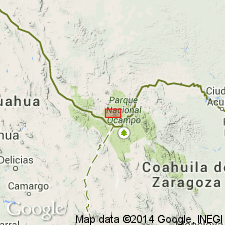
- Usage in publication:
-
- Wasp Spring Member
- Modifications:
-
- Areal extent
- AAPG geologic province:
-
- Permian basin
Summary:
Rocks assigned to the Wasp Spring Member, basal member of the South Rim Formation on Burro Mesa, Brewster Co, TX, Permian basin, were miscorrelated with some rocks of the South Rim Formation near the Pine Canyon caldera. Name Wasp Spring limited to Burro Mesa area. Those formerly assigned to Wasp Spring at Pine Canyon given the "informal" name Burro Mesa Rhyolite [Member] of the South Rim Formation. Wasp Spring thought to be a surge, air-fall, and water-laid deposit that probably covered an area exceeding 100 sq km, had a volume of 2 or 3 cubic km, and was less than 20 m thick. Member unconformably overlies conglomerate of the Chisos Formation or of the South Rim. Contact with overlying Burro Mesa Rhyolite [Member] of South Rim is conformable, though the presence of local scours reported. Oligocene age.
Source: GNU records (USGS DDS-6; Denver GNULEX).

- Usage in publication:
-
- Wasp Spring Member
- Modifications:
-
- Geochronologic dating
- AAPG geologic province:
-
- Permian basin
Summary:
Pg. 25. Wasp Spring Member of South Rim Formation. Ash-flow tuff sample from Emory Peak quadrangle, Brewster County, southwestern Texas, yielded a K-Ar age of 32.9 +/-0.7 Ma (alkali feldspar). Data from D.S. Barker and others, 1986 (Univ. Texas-Austin Bur. Econ. Geol. Gdbk. 23), R.A. Maxwell and others, 1967 (Univ. Texas-Austin Pub. 6711, 320 p.), and D.S. Ogley, 1979 (Univ. Texas-Austin Bur. Econ. Geol. Gdbk. 19, p. 67-71); age recalculated using decay constants of Steiger and Jager, 1977 (Earth Planet. Sci. Letters, v. 36, p. 359-362).
[Age considered Oligocene (from Geologic Names Committee, USGS, 1983 ed. geol. time scale, with additions from N.J. Snelling, 1985, The Geol. Soc. Mem., no. 10).]
Source: Publication.
For more information, please contact Nancy Stamm, Geologic Names Committee Secretary.
Asterisk (*) indicates published by U.S. Geological Survey authors.
"No current usage" (†) implies that a name has been abandoned or has fallen into disuse. Former usage and, if known, replacement name given in parentheses ( ).
Slash (/) indicates name conflicts with nomenclatural guidelines (CSN, 1933; ACSN, 1961, 1970; NACSN, 1983, 2005, 2021). May be explained within brackets ([ ]).

